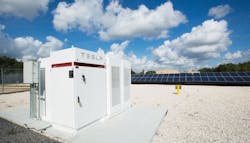Enchanted Rock installing gas-fired Microgrids for three Texas Retirement Living facilities
By Rod Walton, EnergyTech Senior Editor
Houston-based energy firm Enchanted Rock will install microgrids at three retirement living facilities within the company’s home city.
Retirement Center Management (RCM) selected Enchanted Rock to deliver dual-purpose backup microgrids to the Village of Southhamption, the Village of River Oaks and Village of Tanglewood, three RCM sites in Houston. The gas-fired systems will provide protection from grid outages and disruptions.
Winter Storm Uri brought a historically long stretch of below-freezing temperatures to Texas last year. Power generation resources tripped offline and millions of customers lost power for periods of time. Nearly 250 people died.
“We are excited to partner with Enchanted Rock to provide our residents and their families peace of mind that our communities can maintain power under the most difficult of conditions,” said James Gray, Founder and CEO of RCM. “It is mission critical that we keep all of our residents and their families comfortable, and we know Enchanted Rock will allow us to keep our residents protected to live life well.”
Enchanted Rock noted that its microgrids kept power continuous for 140 customer sites during the Uri outages. Those included grocery stores, distribution centers, water districts, health care, manufacturing and senior citizen living facilities.
“It’s an honor to be trusted by the team at RCM to protect their community that impacts so many lives,” said Allan Schurr, chief commercial officer of Enchanted Rock. “We are confident we can keep RCM’s residents safe and communities operational by providing electrical resiliency when utility companies cannot do so during power outages.”
Enchanted Rock fuels all of its microgrids with natural gas supplied from the underground gas infrastructure. Those systems can complement or back up renewable resources.
Commercial, Industrial, and Institutional (CI&I) customers across North America, as EnergyTech contributor John Egan noted in a recent piece, are accelerating their investigation and deployment of battery energy storage systems (BESS) and microgrids, as severe weather like wildfires in the West, hurricanes, flooding, and the Texas deep freeze of February 2021 have dramatized the costs and problems of power outages.
One of the larger microgrid projects recently is the Bronzeville Community Microgrid project in Chicago led by utility ComEd. Enchanted Rock was contracted to provide 5.5 MW in dispatchable natural gas-fired generation as needed for the combined solar, battery storage and gen-set microgrid.
About the Author
Rod Walton, EnergyTech Managing Editor
Managing Editor
For EnergyTech editorial inquiries, please contact Managing Editor Rod Walton at [email protected].
Rod Walton has spent 17 years covering the energy industry as a newspaper and trade journalist. He formerly was energy writer and business editor at the Tulsa World. Later, he spent six years covering the electricity power sector for Pennwell and Clarion Events. He joined Endeavor and EnergyTech in November 2021.
Walton earned his Bachelors degree in journalism from the University of Oklahoma. His career stops include the Moore American, Bartlesville Examiner-Enterprise, Wagoner Tribune and Tulsa World.
EnergyTech is focused on the mission critical and large-scale energy users and their sustainability and resiliency goals. These include the commercial and industrial sectors, as well as the military, universities, data centers and microgrids. The C&I sectors together account for close to 30 percent of greenhouse gas emissions in the U.S.
He was named Managing Editor for Microgrid Knowledge and EnergyTech starting July 1, 2023
Many large-scale energy users such as Fortune 500 companies, and mission-critical users such as military bases, universities, healthcare facilities, public safety and data centers, shifting their energy priorities to reach net-zero carbon goals within the coming decades. These include plans for renewable energy power purchase agreements, but also on-site resiliency projects such as microgrids, combined heat and power, rooftop solar, energy storage, digitalization and building efficiency upgrades.

